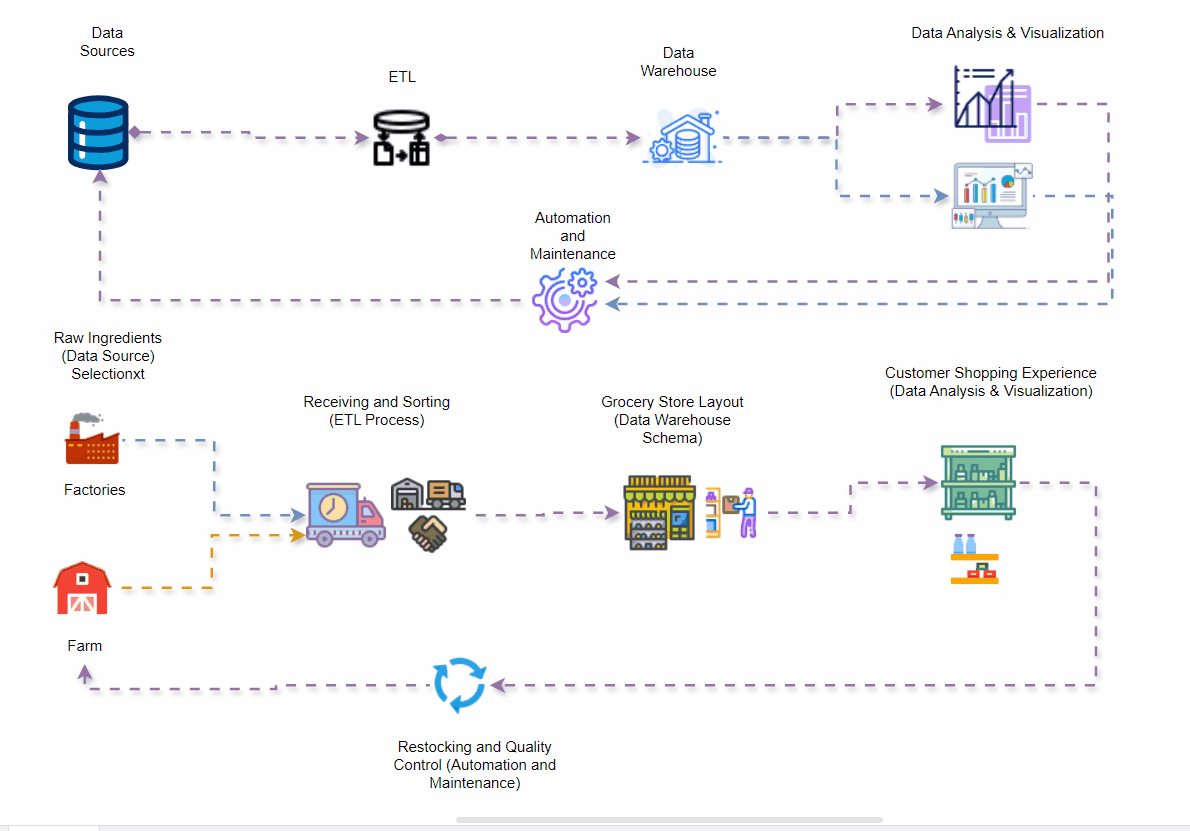Building a Well-Organized Grocery Store: A Metaphor for Your Data Warehouse
 Nhlahla Sibiya
Nhlahla Sibiya
In today’s data-driven world, businesses rely on well-structured data warehouses to make informed decisions. But building a data warehouse can seem daunting, so let’s simplify things with a familiar metaphor: a well-organized grocery store. By comparing each step of the data warehousing process to running a grocery store, we can visualize how raw data transforms into valuable insights.
1. Raw Ingredients Selection: The Data Source
Think of your data sources as the farms, factories, and suppliers where your grocery store’s raw ingredients come from. Just as a successful grocery store relies on high-quality produce and products, a well-functioning data warehouse starts with reliable and accurate data sources. These sources might include customer records, transaction logs, and third-party APIs, all of which feed into your data warehouse. Selecting quality data is crucial to ensuring your end “products” are useful and trustworthy.
Tip: Invest time in identifying diverse and relevant data sources, as they form the foundation of your data insights.
2. Receiving and Sorting: The ETL Process
When your raw ingredients arrive at the grocery store, they must be sorted, cleaned, and organized. Any rotten or damaged goods are discarded, while the freshest items are prepared and displayed. Similarly, in data warehousing, the ETL (Extract, Transform, Load) process ensures your data is clean and ready for use. Data is extracted from sources, transformed to correct errors and format inconsistencies, and loaded into the warehouse.
The ETL process is critical, as it weeds out bad data, ensures consistency, and prepares your data for analysis. Just like a well-organized store shelves only high-quality products, your data warehouse should store clean, accurate data.
Remember: A clean and efficient ETL process ensures your “store” never stocks expired goods—your data is always fresh and usable.
3. Grocery Store Layout: The Data Warehouse Schema
Imagine walking into a grocery store with well-planned aisles and sections, making it easy to find what you need. The store is divided into logical areas: fruits and vegetables, dairy, meats, and so on. In your data warehouse, the layout is similarly organized using schemas.
Dimension Tables are like the descriptive aisles—fruit and vegetable sections that give details about each item.
Fact Tables act as the checkout counters, capturing every transaction, like sales data, in a concise manner.
This structured organization allows your data warehouse to be intuitive and efficient, just like a well-laid-out grocery store makes shopping a breeze.
Insight: A well-thought-out schema ensures that users can find and understand the data they need quickly.
4. Customer Shopping Experience: Data Analysis & Visualization
Imagine shoppers visiting your store, looking for products and deals. The well-labelled signs and organized aisles guide them to their desired items quickly and effortlessly. In the world of data, these “shoppers” are your business users. Data analysis and visualization tools, like dashboards and reports, act as the store signs, helping users navigate the data warehouse and extract meaningful insights.
Clear and engaging visualizations transform complex data into easy-to-understand information, enabling faster, smarter decision-making. Just as a seamless shopping experience keeps customers happy, efficient data analysis tools keep your stakeholders satisfied and informed.
Pro Tip: Invest in intuitive and interactive dashboards that simplify data exploration.
5. Restocking and Quality Control: Automation and Maintenance
A successful grocery store constantly restocks its shelves and performs regular quality checks to keep everything in top shape. Similarly, your data warehouse needs continuous maintenance and updates. Automation ensures fresh data is always available, and regular quality control checks keep data accurate and consistent.
Automated data pipelines and monitoring systems are like your store’s restocking schedule, keeping your warehouse efficient and up to date. Quality checks are essential to catch and fix any data issues before they affect business decisions.
Bottom Line: A well-maintained data warehouse ensures that data is always fresh, reliable, and ready for analysis.
Conclusion
By imagining your data warehouse as a well-organized grocery store, the complex concepts of data sourcing, ETL processing, schema design, data visualization, and ongoing maintenance become easier to understand. Just like a well-run store ensures customer satisfaction, a well-built data warehouse drives business success by providing quality data and actionable insights.
So, the next time you visit a grocery store, think about how its organization mirrors the inner workings of your data warehouse. And remember, whether you’re stocking shelves or building data solutions, quality and organization are the keys to success.
Happy data shopping!
Subscribe to my newsletter
Read articles from Nhlahla Sibiya directly inside your inbox. Subscribe to the newsletter, and don't miss out.
Written by

Nhlahla Sibiya
Nhlahla Sibiya
I'm a passionate data engineer with a deep understanding of modern data warehousing architectures, from traditional data warehouses to the latest cloud-native solutions and data lakes. My journey in data engineering has equipped me with the skills to design and implement scalable, cost-effective, and high-performance data systems that empower organizations to unlock the full potential of their data. I focus on the cutting-edge trends that are shaping the future of data engineering, including AI-driven analytics, serverless architectures, and the seamless integration of diverse data sources. My goal is to stay ahead of the curve and help businesses navigate the complexities of the data landscape. Join me as I explore the evolving world of data engineering, sharing insights, best practices, and the latest innovations in the field.